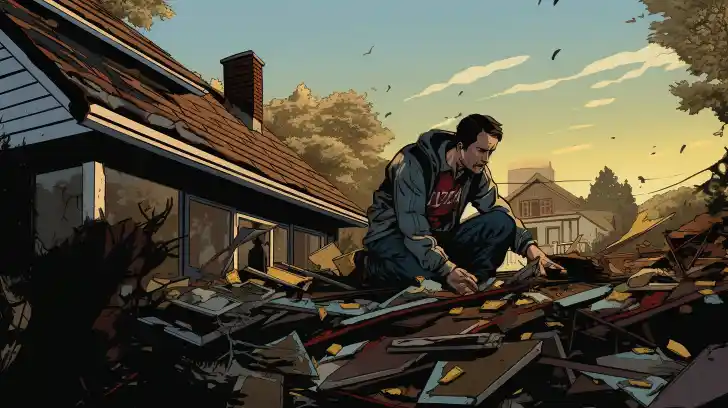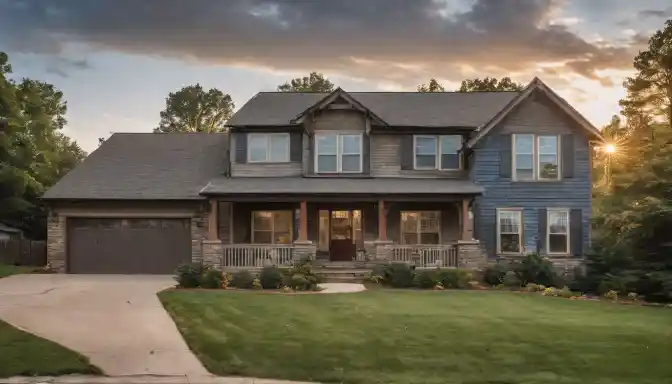Your home is your sanctuary, and the roof above you is its shield, protecting everything beneath it. Imagine waking up to the sound of dripping water or spotting a watermark blossoming on your ceiling.
These are signs that cannot be ignored; your roof may be crying out for help.
Did you know? The lifespan of an average roof ranges around 20 years. But harsh weather, poor maintenance, or simply time passing by might cut that life short. This article will lay out clear warning signs telling you it’s time for a new roof and guide you through steps to address this critical issue before it becomes a homeowner’s nightmare.
We understand how daunting facing a potential roof replacement can seem. That’s why we’ve gathered reliable indicators and expert advice to empower you with knowledge and confidence in making the right decisions.
Just remember – when safety and security are at stake, swift action is key! Keep reading to protect the haven called home.
Key Takeaways
- Your roof should last between 20 and 50 years, depending on the material. Check its age because old roofs may need to be replaced.
- Signs like missing shingles, leaks, or moss mean your roof may need repairing or replacing to keep your home safe.
- If energy bills go up without a reason, it could be because of a bad roof letting heat out. A new one can save you money.
- Look for experienced contractors with good reviews and proper insurance when fixing your roof to avoid more costs later.
- Small problems can sometimes just be repaired but if there’s big damage or many issues, you might need a whole new roof.
Understanding the Importance of a Sound Roof

A strong roof keeps your home safe from rain, snow, and wind. It stops water from getting in and causing mold or damage to your walls and ceilings. Think of a roof as a shield; it takes the hit from storms and hot sun so the rest of your house stays in good shape.
If the roof is old or hurt, it can’t protect you well.
If your roof fails, it could mean big trouble. Water might leak in and ruin things like photos or furniture. The structure of your house could also be at risk if beams get wet and weak.
A poor roof can make heating and cooling cost more too because air leaks out. This means higher bills every month. Taking care of your roof is smart; it’s all about being comfortable, saving money, and keeping your home standing strong for years to come.
Warning Signs You Need a New Roof

As you stand beneath the comfort of your home, it’s crucial to recognize that a failing roof can compromise your safety and wallet. Awareness of the warning signs is key; they signal when repair might no longer suffice, nudging you toward considering a full replacement to safeguard your sanctuary.
The Roof Has Outlasted Its Expected Lifespan
Your roof works hard to protect your home day after day. Like anything else, it won’t last forever. Most roofs are built to last between 25 and 50 years. Think about how old your roof is.
If it’s been up there for a long time, it might be time for a new one.
Materials matter when we talk about lifespan. Metal roofs can stand strong for half a century, while asphalt shingles may need replacing sooner. Look at your own roof’s history – has it had regular checks and fixes? Even with the best care, every roof reaches an age where repair isn’t enough anymore.
If you see missing shingles or your neighbors are getting new roofs, these could be signs that yours needs checking too. Roofs age just like people do! Keep track of how many birthdays your roof has celebrated.
A well-aged roof deserves attention so that you can stay safe and dry under a sturdy one before leaks or damage happen.
Missing or Damaged Shingles
Shingles protect your home from water damage and other outside elements. If they’re missing or damaged, it’s a call to action you shouldn’t ignore.
Leaks and Water Damage
Your home’s roof keeps you safe and dry. But leaks and water damage can spell trouble for your peace of mind, and more importantly, your house. Here’s how to tell if water is getting where it shouldn’t:
- Look at your ceilings and walls inside the house. Do you see brown spots or paint peeling? These are signs that water is sneaking in from your roof.
- Water stains show up as big, ugly patches. If they grow or change shape after rain, this means water is leaking through repeatedly.
- A musty smell in the attic can be a clue. This often means mold or mildew is growing because of moisture from a leaky roof.
- Watch out for sagging spots on your ceiling. They usually mean water has been collecting there.
- If paint outside under your roof is blistering or peeling off, this could be due to water damage.
- Granules in the gutter might come from damaged shingles on the roof that let water slip through.
- Seeing light beams coming into your attic? Light today could mean leaks tomorrow.
- Feel drafts near the ceilings? Cracks or openings are letting air escape—and letting water in.
Moss & Mold Growth
Moss and mold on your roof are big red flags. These unwanted guests show that moisture is sticking around too long up there. Imagine tiny plants growing on your rooftop; it’s not a garden, but a sign that water isn’t drying up like it should.
This trapped moisture can cause all sorts of trouble, from leaks that invite pests into your home to the risk of an electrical fire if things really go south.
Taking care of moss and mold early can save you from bigger headaches later on. Think about what happens when wood stays wet: it rots. And when mold takes over, it doesn’t just stay on the roof – it can spread inside your house and affect the air you breathe.
Cleaning shingles regularly helps stop these problems before they start.
If you see green patches or black streaks up there, don’t ignore them. They mean your roof is holding enough water for plants to grow – not something any homeowner wants! That’s why considering a new roof might be wise to protect everything under it, keeping your home safe and boosting its curb appeal at the same time.
Lackluster Energy Efficiency
Old roofs often do a bad job keeping energy inside your home. If you see your bills for heating or cooling going up, this could mean your roof isn’t working well anymore. Bad energy use can hurt your wallet and is a key sign that you might need to replace the roof.
If sunlight sneaks through cracks in the rooftop, it’s clear that heat or cool air is escaping too. That means you’re paying more to keep your house comfortable. A new roof can seal those gaps and help lower your costs again.
Roofs made with asphalt shingles are common but they aren’t great at saving energy. Over time, they get even worse at this job. You can choose better materials when getting a new roof to make sure your home uses less power and saves money in the long run.
Roof Repair VS Replacement: Factors to Consider
As a senior homeowner, you understand the value of maintaining a safe and secure environment. Your roof is a critical component in ensuring your home remains a haven. Navigating the decision between roof repair and replacement can be complex, but several key factors will guide you to a wise choice.
| Factors | Repair Consideration | Replacement Consideration |
|---|---|---|
| Age of Roof | If your roof is under 20 years old and the issues are minor, repairs might be sufficient. | A roof that has surpassed its expected lifespan, typically 20-25 years, likely needs replacement. |
| Extent of Leaks | Small, isolated leaks can often be fixed without the need for a full roof overhaul. | Multiple leaks or extensive water damage usually indicate the need for a new roof. |
| Damaged Shingles | Sporadic shingle damage might be remedied with simple repairs. | Widespread shingle damage suggests the roof is failing and should be replaced. |
| Energy Efficiency | Roof repairs can sometimes enhance energy efficiency if insulation issues are addressed. | Older roofs often lack modern energy-efficient materials and benefit greatly from replacement. |
| Workmanship | Minor issues resulting from poor installation might be corrected with targeted repairs. | Persistent problems due to initial poor workmanship often require a complete replacement. |
Evaluating these factors helps you protect your investment and ensures peace of mind under the roof over your head. With careful consideration, you’ll make the most informed decision for your home’s longevity and your safety.
Finding the Best Home Remodeling Contractors for Your Roof
You need a good team to fix your roof. Look for roofers who have lots of experience and happy customers. Check if they are in the National Roofing Contractors Association. They should know all about rooftops and how long roofs should last.
Make sure your roofer has insurance and the right papers to work on houses. Don’t pick someone just because their price is low. A good roof will stop leaks, mold, rusting, and save energy too.
It’s better to pay for quality now than have problems later with your mortgage or house repairs.
Choose a contractor who talks clearly about what you need, why you need it, and how they will do the job. They should tell you about price options that fit with being smart about saving money over time – not just today’s costs!
Conclusion
Your roof is your shield. It keeps you dry, warm and safe. If you see signs like leaks, missing shingles or it’s just old, don’t wait. Take action now to make sure your home stays protected.
A good roof means peace of mind in any weather!
To ensure you choose the right professional for your roofing needs, check out our Ultimate Guide to Finding the Best Home Remodeling Contractors.
FAQs
1. How do I know if my roof is too old?
You can tell your roof is too old if you know the roof’s age and it’s near the end of its usual lifespan, or if it looks worn out and damaged.
2. What signs show that I need a new roof right away?
If you see leaks in your house when it rains or find many broken or missing shingles, these are emergency signs that you might need a new roof.
3. Can a new roof be good for the environment?
Yes, picking a new roof with sustainability in mind means choosing materials that are better for our planet and that can help save energy at home.
4. Will I see warning signs inside my house if my roof needs replacing?
Absolutely! If there are water stains on your ceilings or walls, this could mean there are leaks from an old or damaged roof needing quick attention.
Source Links
- https://www.roofon.com/warning-signs-you-need-a-new-roof
- https://www.worthmannroofing.com/signs-for-a-new-roof
- https://longhomeproducts.com/blog/how-do-you-know-if-you-need-a-new-roof/
- https://www.4feldco.com/articles/7-signs-you-need-a-new-roof/
- https://www.weathertightcorp.com/blog/signs-you-may-need-a-new-roof/
- https://www.bustamanteengineers.com/replace-or-repair-the-roof-over-your-head
- https://www.angi.com/articles/7-warning-signs-you-need-new-roof.htm






